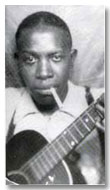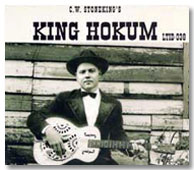| Contents > I’m a Bluesman : The role of perception in the construction of blues music by Andrew Pleffer |
| Page 1 | 2 | 3 | 4 |


(from left to right) Figure 5.1 “Robert Johnson”, in Robert Johnson: The complete recordings, Columbia Records, 1990, p.1; Figure 5.2 “Robert Johnson”, in Robert Johnson: The complete recordings, Columbia Records, 1990, p.4.
Robert Johnson (1911-1938) is the best example of this process (see Figures 5.1 and 5.2). Though researchers are aware of very little information pertaining to his life, enough is known to cast him as a figure of suffering: well-documented musical ability; neatly delimited body of work; wandering life; Faustian legend; and, early/violent/obscure death (Dougan, 2001: 110; Witek, 1988: 192). Even the simplest details like his birthdate and cause of death are open to dispute (Schroeder, 2004: 19). Despite this, there is a massive amount of discourse dedicated to Johnson in journal articles, books, documentaries, plays, and more. With much of this attention focusing on song titles alluding to pacts with the Devil, Robert Johnson is easily the most romanticised, mythologised and famous of the pre-World War II rural blues guitarists. This attention is reinforced by the sheer adoration from contemporary performers like Eric Clapton, John Hammond Jr. and Keith Richards who endorse his influence, reinterpret his songs, and credit him with inventing rock-and-roll.
Though he was, without question, a highly talented musician, Johnson’s residence in the blues canon did not occur until his recordings were reissued to a blues revival audience in 1961, 1966 and again in 1990. Prior to the 1960s, Johnson – as a recording artist – was considered relatively insignificant for his time. So why the sudden popularity?
In addition to the boundless promotion from contemporary performers and record companies, a recent theory proposes that Johnson’s appeal stems from his use of elements that were unusual for rural blues recordings in the 1930s (e.g. coherent themes, musical introductions, evocative metaphors, etc.). Here Eric Rothenbuhler argues that audiences of recorded music culture from the 1960s onwards identify Robert Johnson’s recordings as sounding “polished” and “qualitatively superior” when compared to those of his contemporaries (2007: 65, 67). Interestingly, this line of reasoning reveals cultural values concerning sound and music, which, when coupled with the absence of information about Johnson’s life, contribute to his allure and posthumous success. Thus, from humble beginnings struggling against the standards of the 1930s, Johnson becomes an unfulfilled genius ahead of his time; a perceived icon of contemporary music, more so than that of his day.
Other writers, however, argue that the obscurity, mystery, misinformation and misconceptions surrounding Johnson’s life are all significant factors contributing to his allure, especially among the white blues audience (Pearson, 1992: 121-123; Wald, 2004: 188, 221, 274-185). Neglected for years by African-American music lovers, Johnson’s music laid dormant only to be resurrected later by a group of writers and musicians who “helped usher in an era of unprecedented white appreciation of the blues” (Tracy, 1999: 504). Just as the marginalisation and segregation of the genre fulfilled a ‘white’ desire to control the blues discourse in the 1920s, elevating Johnson to the status of unrecognised genius through posthumous revisionism satisfies the same need. Both situations imagine the bluesman as primitive other while elevating white cultural sensitivities, limiting both blues music and blues musicians to a homogenous stereotype. This interpretation, however, is often ignored as it spoils the romance and its commercial possibilities (Wardlow, 1998: 201).
Accordingly, this homogenous perception has been propagated by a large number of performers who have built themselves blues personas that self-consciously mimic this image (Wald, 2004: 8). The best example of this phenomenon in contemporary Australian music is a performer known as C.W. Stoneking (see Figure 6.1).

Gaining reputation recently through tours and his participation in The dig Australian Blues Project, Stoneking embodies the perpetuated romantic image of an early rural blues guitarist. Born and raised in Australia to Californian parents, he borders on blackface minstrelsy (sans blackface) and approximates an African-American accent he describes as sounding “like a Deep South pirate” (Lobley, 2007: non-paginated). As demonstrated by his latest album, both his sound and appearance are clearly modelled off the very perception discussed above. Accordingly, an excerpt from his website reads:
-
He wears a ragged black suit and a preachin’ hat, makes tunes about singing dodo birds, hollers like a 1920’s [sic] tent show blues shouter, plays guitar like a demon, and mutters to himself onstage. The legendary king of hokum blues, C.W. Stoneking, is a true entertainer who relies on musicianship, stagecraft, and performance to invoke the spirit of 1920’s [sic] Southern blues in his original hokum style. (http://www.myspace.com/cwstoneking)
Here Stoneking self-consciously mimics the bluesman image through old-time references (e.g. hokum), wardrobe, repertoire, guitar playing style, and the use of a vintage resonator guitar in order to appear ‘authentic’. Some interview excerpts even reveal his attempts to live the bluesman lifestyle – living in a farmhouse, working as a handyman and spending all of his money on alcohol (Anonymous, 2005a: non-paginated; Dawson, 2004: non-paginated). Additionally, Stoneking unquestionably accepts the talented-but-uneducated perception of the bluesman and all the political baggage it carries.
In addition to demonstrating the continued romanticisation by white blues aficionados, Stoneking is one of many musicians who present a preoccupation with impersonating the bluesman better than the bluesman himself. Manifested in different ways by different musicians, these ‘mimics’ take great pride is sounding like African-Americans. Matthew ‘Dutch’ Tilders provides another Australian example of this tendency. His website happily boasts: “In 1976, having only heard Dutch, B.B. King assumed that he was black. Brownie [McGhee] and Dutch became best mates simply because Browney [sic] believed that the Dutchman was a genuine bluesman, regardless of his racial origins” (http://www.dutchtilders.com.au/biography.htm). Accordingly, Tilders subsequently named one of his albums I’m a Bluesman (1998). He takes great satisfaction in recounting these comments from famous African-American bluesmen as they are intended to validate the authenticity of his craft and illicit the response, ‘he’s so good, he might as well be black!’
Without entering into the ridiculous ‘can whites sing the blues’ debate of years past, it is important to acknowledge that blues remains an African-American musical innovation. The best values for identifying an authentic blues performer should concern the degree of their mastery of the idiom and the level of regard they afford to their sources of inspiration and technique – not race or sex (Rudinow, 1994: 135). By unquestionably accepting the image of the bluesman we unquestionably accept that which has been removed from memory.
The search for validation as a legitimate bluesman seems to be manifest in a ‘tyranny of distance’ (Blainey, 1966: viii-x). From the traces of blues music recorded in the early twentieth-century and photographs of early bluesmen, our culture has constructed an image – a perceived essence or distillation – that puts a face to a name. The distance of time and place that exists from the 1920s Deep South is the very factor that gives life to the romantic bluesman figure. Virtually all of the musicians who fit its criteria are now dead, and, in order to fulfil the preconceived expectations of our culture, some contemporary performers are seeking to reproduce elements of the constructed archetype. Not to be confused with reality, these conscious efforts to resurrect the atmosphere attached to blues music are attempts to mimic or impersonate an idea, a perception that our culture has continuously constructed, anticipated and fed – consciously or not.
This Romanticism, however, masks the fact that the 1920s Deep South was ruled by racial oppression, racial violence, misogyny, and a post-slavery environment in which the dynamics remained seemingly unchanged. In the words of Jeff Lang, another blues-influenced musician from Australia, it was no a bed of roses for an African-American musician (J. Lang, personal communication, February 17, 2006). Even with this awareness, though, the perception of the bluesman still persists, the following response representing blues music as defined by Lang himself:
-
I immediately think of the originally recorded guys. I think blues music and I immediately picture Son House, Charley Patton, Robert Johnson, Tommy Johnson, Skip James. Then there’s the sort of gospel side of it with [Mississippi] Fred McDowell, Blind Willie Johnson, Reverend Gary Davis, and the raggy sort of guys like Blind Blake, Blind Boy Fuller, Bo Carter, Blind Willie McTell… Mississippi John Hurt… Blind Lemon Jefferson… Robert Pete Williams… And then maybe also the early Memphis and Chicago stuff like early Howlin’ Wolf and Muddy Waters… Little Walter… that’s what I picture in my head when I think of blues music. (ibid)
Though he does not consider himself a “blues artist”, Lang confirms the common expectation by listing eighteen African-American bluesmen, all of whom are now dead. Most, if not all, were born in the Deep South in the late-nineteenth and early-twentieth centuries; seventeen played guitar; twelve bore nicknames; eight bore triple-barrel names; and, six were blind. Finally, each one participated in the blues genre, at least to some extent, with all eighteen musicians continually appearing in discographies and encyclopedias such as The Penguin Guide to Blues Recordings (Russell, Smith, Slaven, Russell, & Faulkner, 2006).
A similar response is also elicited from Mia Dyson, an Australian musician influenced by blues music. Interestingly, Dyson prefers to shun the “blues artist” tag because she grew up in a beachside resort town, prefers tea to whiskey, and plays more than just blues (she also plays folk and country) – not because she is a woman (Anonymous, 2005b: non-paginated). Even so, instead of challenging the established archetype, Dyson chooses to perpetuate the dominant mythology of the quintessential blues musician as a narrow-minded, rural-dwelling, liquor-loving man.
Evidently, the perception of the bluesman is one that wields great power. Furthermore, it is also a memory that satisfies the majority of the blues audience, one that many are happy to share and perpetuate. Listeners like to hear lyrics about the rambling womaniser, the troublesome troubadour, and the pact with the Devil. Whether the attraction occurs as a result of the romantic narrative, a desire to live such a ‘carefree’ life, or from some kind of resonance with the persona projected through song, this is the bluesman many have come to know.
Real or not, this particular representation has achieved centrality over other perspectives which have been marginalised or excluded altogether (as cited in Hamilton, 2001: 22). Thus the blues canon that continues to be disseminated is full of heterosexual male performers from both past and present. Even if they are not strictly solo performers, they are most certainly known for their individual prowess, asserting their own identity through writing their own songs, characteristic vocals and/or impressive instrumental solos. This safely ensures that the perception of the early twentieth-century bluesman and his music are set to remain the same for quite some time.
| Page 1 | 2 | 3 | 4 |
| Contents > I’m a Bluesman : The role of perception in the construction of blues music by Andrew Pleffer |
